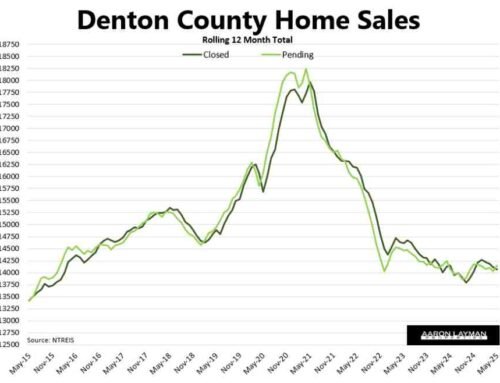North Texas real estate is going to get coronafied, and the coming months will reveal the extent of what looks to be lasting damage for the local real estate market. The official press release estimates compiled by the A&M RECenter and regurgitated by major media outlets pegged March home sales for a 4 percent increase. It’s important to keep in mind these press release numbers are statistical estimates which run off of algorithms accounting for late closings. Sometimes the padding added for late closings or contract activity is overdone, and I believe March is one of those months.
The March numbers for actual closings and home prices are irrelevant in this context. What matters are the forward looking indicators. NTREIS Trends figures as of April 10 show closed sales which were down 0.4 percent. If you believe the press release estimate, we’ll end up with a 4 percent sales gain for March. I think that’s possible, but optimistic. I certainly don’t believe the estimate for a 10 percent decrease in pending home sales. Trends data shows a 19.9 percent decrease in pending sales as of April 10.
In a normal month, we would see that pending sales figure improve by several percentage points from the 10th through the end of the month as the late closings and sales figures are added in. Here’s the problem. March was NOT a normal month. It was Earth shattering in a number of ways. While major media outlets are busy regurgitating press release sales estimates, I think that is a mistake.
The algorithms which account for late closings likely won’t be capturing the extend of the fallout in pending contract activity. In a normal month, you can assume most pending sales scheduled to close that moth actually make it to funding. Things went seriously haywire in March as millions of Americans filed for unemployment. Some pending contracts may never make it to the closing table..ever. This a cold hard fact that will likely be dismissed by many in the real estate industry. The official press release estimate for pending sales appears to be dismissing this unfortunate reality as well.
I think it’s safe to assume the actual pending sales declines for March are going to be worse than official press release estimates. I think the pending sales decline for March is more like 14 or 15 percent for North Texas. My estimate for the March pending sales decline for Denton County is 11 percent, and it’s the best of the four largest counties in the DFW area. Pending sales look to be down 20 percent in Dallas County. My estimate for Tarrant County is a 16 percent decline. It looks like Collin County is in for a 17 percent decline for March pending sales.
Some of the smaller counties like Rockwall and Ellis will post smaller declines in March pending sales, but Wise County wasn’t that fortunate. It looks like pending sales will down over 20 percent there. Similar to the 2018 downturn, Frisco is apparently going to get hit again. It looks like pending sales are down about 25 percent for that area in March.
Some markets will fare better than others in in the coming downturn, but I’m not one of those calling for a V-shaped recovery or a quick resumption to normal. From what I can see, the structural damage to the economy and the real estate market has been deeper than many appreciate. I think our entire construct of “normal” is going to change, and in some ways this will be a good thing.
I had a good chuckle last month when a local hedge fund guy made the laughable argument that the U.S. banking system was healthier than it was leading up to the Great Recession. You know, because all of those wonderful Swiss cheese reforms that were instituted after the Great Recession and because we learned our lesson since all of the miscreants who caused and profited from the last crisis have been punished.
Here we are a month later, and the reality hiding in plain sight is now common knowledge to just about everyone, especially for the 16 million newly unemployed Americans waiting for a stimulus check. Yes, the U.S. financial system is so strong that the Federal Reserve is in full blown panic mode, adding over $2.3 trillion to its balance sheet and circumventing the Federal Reserve Act to bailout out every zombie institution on Wall Street, regardless of the moral hazard involved. The Fed’s balance sheet has now exploded to over $6 trillion, and it is going to grow even larger.
The past few weeks have brought a number of unprecedented events for the American economy, none more important than the Federal Reserve’s effective merger with the U.S. Treasury. The Fed has effectively abandoned any all pretense of “independence” in a bid to goose equity prices higher. With the recent actions to effectively take over the entire U.S. bond market, buying corporate debt, junk debt and even ETFs, the goons at the Federal Reserve have just confirmed what many people like myself have been saying for years. The Fed doesn’t give a damn about Main Street America, and certainly not working Americans. The Fed just ignored Section 13(3) of the Federal Reserve Act and decided it will bail out billionaires, hedge funds and private equity parasites, even if they were serially mismanaging their businesses or wasting $billions on share buybacks which should have gone to capital investment and/or employees.
The effective merger between the Fed and Treasury pushed stocks higher despite the news that 6.6 million Americans were added to the unemployment rolls in the last week, on top of the 6.8 million unemployed the previous week. That tells you everything you need to know. In an election year this was absolutely a calculated political decision to keep the stock market afloat come Hell or high water. It also ensures that wealth and income inequality in the U.S. are going to get worse.
This is important to keep in mind since Wall Street has already received $trillions in stimulus. The Federal Reserve was shoveling $billions into the overnight repo markets as early as last September to help unspecified banks. Free market capitalism as we understood it was already on the ropes, but the Powell Fed and Mnuchin Treasury just put it out of its misery. Pam and Russ Martens detailed how Jerome Powell made a mockery of the Federal Reserve Act while telling some absolute whoppers to the American public.
“Clearly, there are many corporations with junk bond credit ratings that should use the legal proceeding known as bankruptcy filing and not be bailed out by the Fed.”
Individual citizens are still waiting for a $1200 check and/or unemployment benefits while small business owners are depending on U.S. banks (some of the same banks which have pleaded guilty to felony counts for blatant violations of the law) to process loans to save their dying Main Street businesses. As Matt Taibbi put it, we’re bailing out the last bailout. We are doubling down on failure and inequality in America. It’s enough to make your head spin, particularly since the entire charade has has received bipartisan support in Congress to this point.
For a brief summary of why Wall Street has already been bailed out and you haven’t, I highly recommend Matt Stoller’s piece on the Cantillon Effect. Richard Cantillon was an 18th century French banker and philosopher. Cantillon noticed that when the state prints a bunch of money (like the Federal Reserve is currently doing), it is not equally distributed. Cantillon noticed that the closer you were to the king or the wealthy, the more you benefited. The further away you were, the more you were harmed. If that sounds like a description of modern America, you would be correct. We are currently witnessing those distributional effects in action.
Social Capital CEO Chamath Palihapitiya summed it up brilliantly in a blistering interview outlining the moral hazard of the Fed and Treasury’s recent actions while explaining the lie floated by Wall Street:
“On Main Street today, people are getting wiped out. Right now, rich CEOs are not, boards that have horrible governance are not, hedge funds are not. People are… What we’ve done is disproportionately prop up poor-performing CEOs, companies and boards, and you have to wash these people out.”
Major real estate brokerages have already furloughed a large number of their agents. Redfin recently furloughed 41 percent of its agents. The Mortgage Bankers Association index of purchase applications was down 33 percent year-over-year in the latest weekly survey. Banks are tightening mortgage lending standards, pulling back from riskier loans and even jumbo loans in some cases. Across the globe, listing activity has plummeted in areas which have been sheltering in place. Active listings in New York have fallen off a cliff. Things are certainly better in North Texas, but the drop in contract activity is already noticeable. Fewer listings and contracts means fewer sales, and this is all taking place heading into what should be one of the busiest times of the year for real estate activity.
Some perfectly nice people in the local real estate industry are still optimistic that we’ll soon get back to normal and even higher sales levels. The data suggest that’s not going to happen for quite a while. Millions of unemployed Americans are already deferring mortgage payments. Millions more are skipping paying rent. Mortgage forbearance is not the same as mortgage forgiveness, and many deferred mortgage payments will inevitably lead to more defaults as the deferred payments come due. Many small businesses have already shut their doors. Some will never reopen. The businesses which are lucky enough to survive are going to be staring at different economy with different underlying demand.
Shutting down the world’s largest economy on the planet, even for just a few months, is going to have profound, long lasting consequences. The policy responses at the federal level, and particularly from the Federal Reserve, are going to compound the problems for working Americans. This is something I think many in the real estate industry are ignoring.
Doubling down on trickle-down monetary and fiscal stimulus is going to make any recovery for the real estate market extremely challenging. The con artists at the Federal Reserve want you to believe they support stable prices and full employment. They want you to think they seriously support Main Street. Their actions suggest exactly the opposite, and I think the data in the real estate market in the coming months will only confirm it.













Leave A Comment